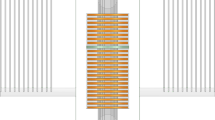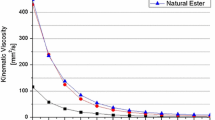Abstract
Power transformers represent an important part of the capital investment in transmission and distribution substations. The cooling of the windings (electrical coil) depends on the convection of heat, enhanced by the forced circulation of oil through the windings and heat exchangers. The forced circulation of oil combined with the forced circulation of air in the heat exchangers is usually found in mobile transformers, whose compact structure is a challenge in terms of heat transfer rates. An improper design or fabrication problem associated with the assembling of the cooling system may result in an inefficient exchange of heat, which may lead to transformer failure from overheating or a reduction of the life span. In this context, the present work proposes a 2D mathematical model to simulate the winding cooling system of a 138 × 69–34 × 13.8 kV 25 MVA Mobile Power Transformer with the objective of investigating the causes of overheating. The model is implemented in CFD Ansys-Fluent® version 17.0 and validated with experimental data. It is evaluated the velocity and temperature distribution, and the identification of the hot spots on the transformer operating considering the nominal conditions for oil flow rate, inlet temperature, and power dissipated. The hot spot temperatures are compared with the current Brazilian Association of Technical Standards—NBR 5356-2: 2007 Power Transformers Part 2: Heating. After, some geometric and/or operational constraints are artificially imposed on the transformer. Their impact on the velocity and temperature fields, as well as the hot spot temperatures, are mapped in order to verify if they still respect the standard´s temperature limits and if imposed constraints may lead to the transformer failure. The numerical results clearly illustrate that geometric imperfections in the disks, guides, or axial cooling ducts have a direct impact on oil flow and temperature distributions. These imperfections can also alter the positioning and significantly increase the temperature of the hottest spot within the winding, sometimes even exceeding the requirements of the ABNT NBR 5356:2 standard in certain scenarios. Therefore, the proposed mathematical model serves as a valuable tool for investigating a complex and common issue within the energy distribution system. This issue not only inconveniences the population but also leads to economic challenges each year. Finally, the outcomes of this study can provide engineers with essential insights to enhance the thermal design of power transformers, as well it can assist in guiding maintenance efforts and understanding the root causes of new failures.









Similar content being viewed by others
References
Hamza S, Herskind T (2019) Dynamic thermoelectric modelling of oil-filled. In: Transformers for optimized IEEE Institute Of Electrical And Electronic Engineers. IEEE 1538:2000. Guide For Determination Of Maximum Winding Temperature Rise In Liquid Filled Transformers, 2000
Daghrah M, Wang Z, Zhongdong W, Qiang L, Jarman P, Walkerb D (2020) Flow and temperature distributions in a disc type winding-Part I: forced and directed cooling mode. Appl Thermal Eng, 165
Radakovic ZR, Sorgic MS (2010) Basics of detailed thermal-hydraulic model for thermal design of oil power transformers. IEEE Trans Power Delivery 25:790–802
Torriano F, Picher P, Chaaban M (2012) Numerical investigation of 3D flow and thermal effects in a disc-type transformer winding. Appl Thermal Eng, 40
Ortiz C, Skorec AW, Lavoie M, Benard P (2009) Parallel CFD analysis conjugate heat transfer in a dry-type transformer. IEEE Trans Industry Appl 45:1530–1534
Torriano F, Chaaban M, Picher P (2010) Numerical study of parameters affecting the temperature distribution in a disc-type transformer winding. Appl Therm Eng, 30
Quintela B, Torriano F, Campelo HM, Labbéa PM, Pichera P (2018) Numerical and experimental thermal fluid investigation of different disc-type power transformer winding arrangements. Int J Heat Fluid Flow
Fonte CM, Lopes JC, Dias MM, Sousa RG, Campelo HM, Lopes RC (2011) CFD Analysis of Core Type Power Transformers. In: 21st international conference on electricity distribution. Frankfurt 6–9, June 2011.
Tsili MA, Amoirales EI, Kladas AG, Souflaris AT (2012) Power transformer thermal analysis by using an advanced coupled 3D heat transfer and fluid flow FEM model. Int J Thermal Sci 53:188–201
Jarman P, Zhang X, Daghrah M, Liu Q, Wang Z, Dyer P, Gyore A, Smith, P, Mavrommatis P, Negro M (2012) Prediction of the oil flow distribution in oil-immersed transformer windings by network modelling and computational fluid dynamics. IET Electric Power Appl
Haritha VS, Rao TR, Amit J, Rammamorty M (2009) Thermal modeling of electrical utility. In: Third international conference on power systems, Kharagpur, India, 27–29 Dec 2009
Campelo HMR, Fernandez XL, Picher P, Torriano F (2013) Advanced thermal modelling techniques in power transformers. Review and Case Studies. ARWTR2013—Advanced Research Workshop on Transformers, Baiona, October 2013
Daghrah M (2017) Experimental study of transformer liquid flow and temperature distributions. Thesis (The Degree of Master), The University of Manchester
Santisteban A, Ortiz F, Carlos JR, Perez S, Mendez C, Fernández CD (2019) Thermal modeling of power transformer with different dielectric liquids. XI National and II International Engineering Thermodynamics Congress—2019. Responsibility Notice.
WEG (2020) Manufacturer's catalog—design review: remote controlled regulator transformer
Picher P, Torriano F, Chaaban M, Gravel S, Rajotte C, Girard B (2010) Optimization of transformer overload using advanced thermal modelling. CIGRÈ Session, Paris
Nynas AB (2014) Product Data Sheet: Nytro 11GBX-US, 2014.
Yaqoob MT (2013) Transformer thermal model of the disk coils with non directed oil flow. Masters thesis, Universiti Tun Hussein Malaysia
Zhang X, Wang ZD, Liu Q (2017) Interpretation of hot spot factor for transformers in OD cooling modes. IEEE Trans Power Delivery
IEEE Institute of Electrical and Electronic Engineers. IEEE 1538:2000. Guide for determination of Maximum Winding Temperature Rise in Liquid Filled Transformers, 2000.
Shimizu S, Murata H, Honda M (1979) Electrostatic in power transformer. IEEE Trans Power Apparatus Syst Pas-98(4)
Bustin WM, Dukek WG (1983) Eletrostatic hazards in the petroleum industry. Research Studies Press Ltd. England
Cesar LC, Vieira S, Sens MA, Marins LE, Fernandez JB (1989) National Seminar on Production and Transmission of Electric Energy, Curitiba
Author information
Authors and Affiliations
Corresponding author
Additional information
Technical Editor: Guilherme Ribeiro.
Publisher's Note
Springer Nature remains neutral with regard to jurisdictional claims in published maps and institutional affiliations.
Rights and permissions
Springer Nature or its licensor (e.g. a society or other partner) holds exclusive rights to this article under a publishing agreement with the author(s) or other rightsholder(s); author self-archiving of the accepted manuscript version of this article is solely governed by the terms of such publishing agreement and applicable law.
About this article
Cite this article
Moura, L.M., Huebner, R. & Trevizoli, P.V. Numerical evaluation of the directed oil cooling system of a mobile power transformer. J Braz. Soc. Mech. Sci. Eng. 46, 209 (2024). https://doi.org/10.1007/s40430-023-04625-9
Received:
Accepted:
Published:
DOI: https://doi.org/10.1007/s40430-023-04625-9




